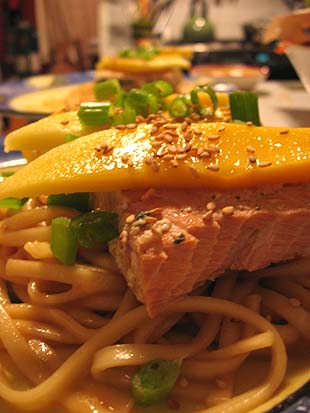
This is the meal we had during a break from the armoir assembly. It may sound like a lot of steps but it comes together very quickly. And it was really good — I loved the soy dressing. The original didn’t call for wasabi but I had some wasabi oil from Trader Joe’s and decided to add some of that — so good. If you don’t have a TJ’s by you (or you don’t want to get any wasabi oil) just add a little wasabi to the blender with the other ingredients — but just a little.
The mango adds both a nice texture and a sweet compliment to the spicy and the salty. And what can I say about the udon noodles besides — I love noodles! Soba noodles will work too, though.
Oh and I have a question for all you expert salmon poachers out there. Sometimes I get those white clumps coming from my salmon as I poach it — is there a good way to avoid that happening? I poach salmon very rarely but this seems to happen to me maybe half the times that I do poach salmon. Any tricks to avoid this? Thanks! There’s a great explanation/tip from Jacque in the comments.
If you are more a fan of grilling than you are of poaching (as I usually am) you could also try grilling the salmon with salt, pepper, oil and a bit of sake brushed onto the fish while cooking. I bet that would be pretty good too!
Sake-Poached Salmon with Mango & Soy Dressing Over Udon Noodles
Based on a recipe by Ming Tsai
For the salmon:
1 cup sake
1 celery, sliced
1 peeled carrot, sliced
1 small onion, sliced
1 tbsp sugar
1 tbsp chopped parsley
2 bay leaves
8 black peppercorns
2 tbsp soy sauce
Water
1 lb salmon fillets, skin removed
Salt and pepper
For the dressing:
1/2 cup ponzu
1 large shallot, quartered
1 clove garlic
2 tbsp Japanese soy sauce
1/2 tbsp sugar
1/4 cup wasabi olive oil + 1/2 cup olive oil or 3/4 cup olive oil and 1/4 tsp wasabi paste
The rest:
2 bunches udon noodles
1 mango, peeled and sliced
2 sliced scallions
sesame seeds for garnish
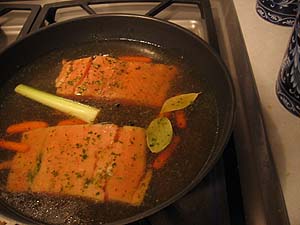
In a large sauce pot, mix the sake, celery, carrot, onion, sugar, bay leaves, parsley, peppercorns and soy sauce. Add the seasoned salmon and add water to cover. Slowly bring the liquid to a simmer. Simmer for 3 minutes then turn off the heat. Let stand for 5 to 10 minutes depending on doneness desired.

In a blender, add ponzu, shallot, soy, and sugar. If using wasabi paste add that too. Blend on high speed and drizzle in the oil. Season with salt and pepper.
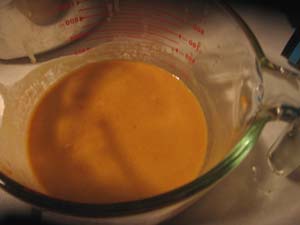
In a large bowl, mix together the cooked udon noodles and enough enough vinaigrette to coat. There will be some left over for plating. Check for seasoning.
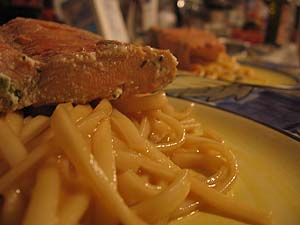
Plating: On a large plate, place a mound of the noodles and top with hot salmon and top with a few mango slices. Garnish with the diced scallions and sesame seeds. Drizzle on a little of the vinaigrette over the top and serve.
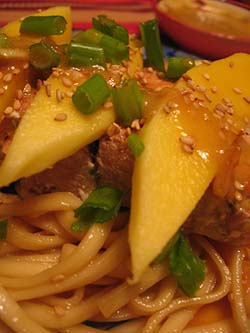


Another winner!
i’ve always heard the white stuff means its fully cooked, or overcooked depending on how you like your fish.
Cyn: Ah, well there you go. This salmon I did let sit for the whole 10 minutes in the poaching liquid, as I was using thawed (previously frozen) salmon and wanted to cook it all the way, rather than leaving it a bit rare.
Kalyn: Thanks!
Hey! I read your post yesterday before I went to class, and as fate would have it- we talked about poaching salmon last night.
The white stuff that foams up is albumin protein (the same stuff found in egg whites). Too avoid the foaming, you should make sure your salmon and your poaching liquid start out at the same temp (room temp.), and gently simmer, never boil, until the fish goes opaque.
So say the gurus at culinary school!
love,
j
Jacque:
Thank you so much!!! My salmon was right from the fridge before starting and I believe it hit a low boil for a few seconds while I was watching the furniture assembly!
Excellent tips — I greatly appreciate it! 🙂
Wonderful recipe! Adding to Jacque’s thoughts, I add my room temp salmon to the simmering broth, let it simmer just a few minutes more on heat then remove it and let it sit off heat until just opaquely done. It works every time and no white stuff.